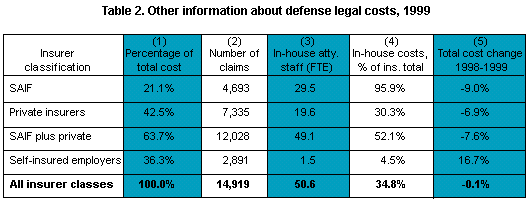
In 1999 Oregon workers’ compensation insurance carriers and self-insured employers (together referred to as “insurers”) paid over $24.0 million for attorney salaries, attorney fees, and other costs of legal services incurred in accordance with Chapter 656, Oregon Revised Statutes. These costs are primarily to defend the insurer against claims or compensation benefits believed to be unwarranted, but may also include costs to represent the insurer in responsibility disputes (where the outcome may not directly affect the worker) and for services provided outside of litigation (such as negotiating a claim disposition agreement). These costs are distinguished from fees paid to attorneys representing injured workers.
Table 1 summarizes these costs. The bottom row of the table
depicts the breakdown of costs by category: 65.2 percent of all costs
were for retained counsel, compared to 61.8 percent in 1998.

The graph below depicts total defense legal costs for the past 10 years, the only period for which data are available. Total costs in 1999 were only $13,000 (0.054 percent) less than in 1998. The cost decrease was due to the reduction of in-house costs (this was the case a year ago, also), since costs for retained counsel increased by over 5.5 percent from 1998 to 1999.

For each insurer classification, information on share of costs, numbers of litigated claims, in-house attorney staff, in-house costs as a percentage of all costs, and 1998-1999 cost changes are given in Table 2.

Self-insured employers’ share of total costs (column 1) increased over 1998 by 5.2 percentage points, while SAIF and private insurers’ shares decreased by 2.1 and 3.2 percentage points, respectively. The number of claims (column 2), which approximates the numbers of claims with litigation during the year, increased over 1998 by 13.7 percent. Previously, the total number of such claims had fallen every year since 1990. The numbers of in-house attorney staff (full-time equivalent, or FTE) are given in column 3, and the percentages of all costs that are composed of in-house costs are given in column 4. SAIF use of in-house staff has always been greater than for the other insurer classifications. For 1999, 95.9 percent of SAIF’s legal costs were in-house costs, slightly above 1998’s 95.4 percent. Finally, column 5 gives the 1998-1999 changes. Costs paid by self-insured employers increased by 16.7 percent over 1998, while SAIF and private insurers paid less.
A total of $20.2 million – 83.9 percent of all defense costs – was paid to attorneys (attorney salaries plus retained counsel), up from 81.3 percent in 1998. (We assume for this purpose that billings for retained counsel are all attorney fees, but other costs to the law firm may be included, as well.)
This report is based on data submitted by insurers as required by ORS 656.388(5). Surveys were sent to over 400 such companies that had claims in litigation during the year. About 97 percent of the companies responded to the survey; responding companies were responsible for 99.8 percent of the litigated claims.
If you have questions about the information contained in this document please contact by e-mail or phone: Russ Reed, Research Analyst, Research & Analysis Section, Information Management Division (503) 947-7343.
This document was originally published in February 2001.
[Printed form: 440-2314 (03/01/IMD)]
In compliance with the Americans with Disabilities Act (ADA), this publication is available in alternative formats by calling (503) 378-4100 (V/TTY).
The information in IMD publications is in the public domain and may be reprinted without permission